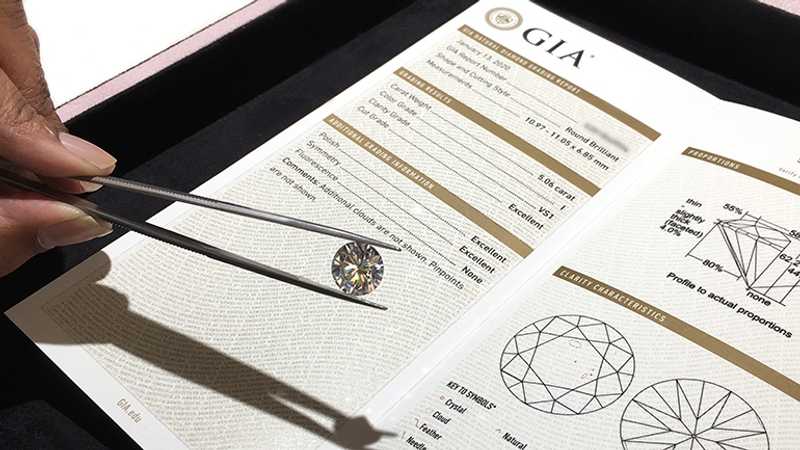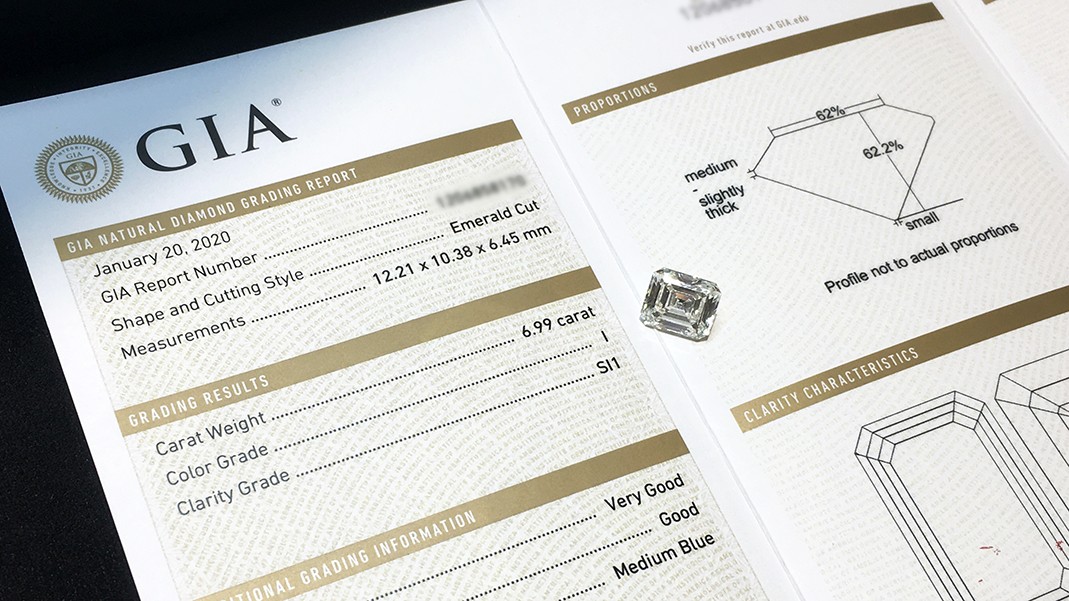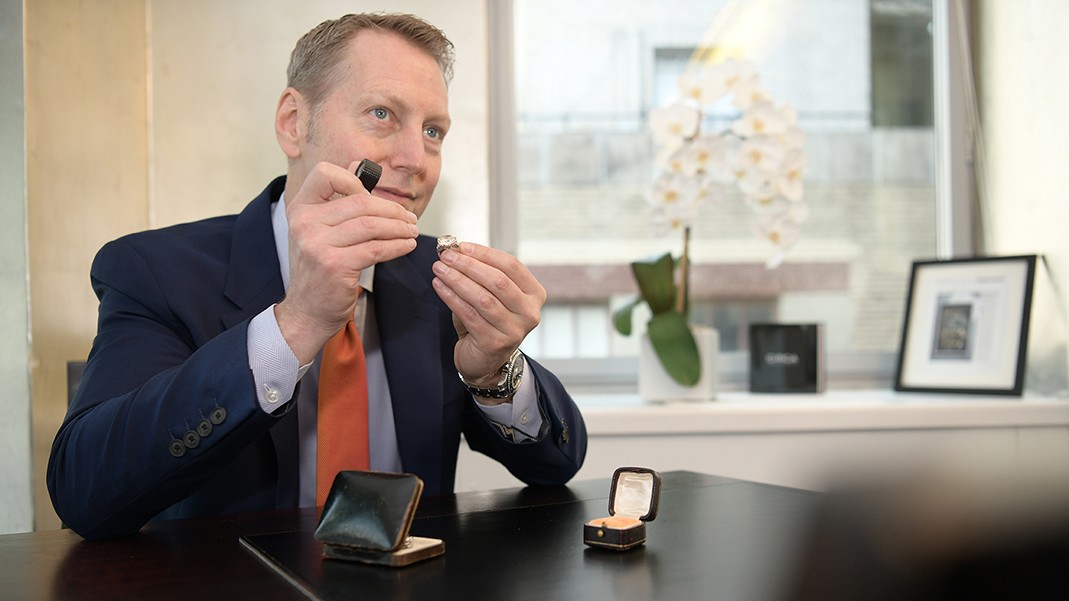Understanding
a GIA Diamond Grading Report

Understanding a GIA Diamond Grading Report
If you are looking to sell your diamond, you may be aware of the GIA Diamond Grading Report, and how having one could impact the amount of money you receive for yours. A GIA report could be helpful when determining the value of your diamond, so it’s a good idea to get familiar with all the important information provided by it. GIA provides detailed information on the unique characteristics of a diamond. After inspection by GIA’s Graduate Gemologists, the diamond is graded on multiple fronts. But it is the interpretation of this data by a professional diamond buyer, coupled with current supply and demand, which will ultimately determine the value of your diamond – not the report itself.
If you have a Diamond Grading Report from a reputable lab, CIRCA can provide an indication of the diamond’s value, sight unseen. However, you should note that different labs have different criteria for grading diamonds, and so the same diamond may receive a different grade than the GIA, for example, than it might from another lab. Since a diamond’s desirability - and therefore its value - is based on its overall beauty, it is only after a physical examination that our buyers would determine the value of your diamond.
If you don�’t have a Diamond Grading Report, that’s okay too. CIRCA prides itself on the skillsets of our highly trained diamond buyers who physically examine each diamond with or without GIA reports, and look for the nuances which will maximize your diamond’s value. So while a GIA Diamond Grading Report can be helpful when you sell your diamond, it is not necessary in order to receive and offer from CIRCA.
Let’s take a look at a typical GIA Diamond Grading Report, what data is included, and how to interpret this information in relation to your diamond.
What is a GIA Diamond Report?
A GIA Diamond Grading Report is a document that the Gemological Institute of America (GIA) provides after a thorough and meticulous examination of your diamond. It provides information for every important characteristic of your diamond. There is more to your diamond than its cut, color, clarity and carat weight. Every single diamond is unique. In fact, each one was exposed to different conditions and natural elements when it formed beneath our Earth’s crust, and is also susceptible to wear and tear above the surface– so every individual scratch, inclusion, blemish, and identifier that is unique to your diamond may appear on this document.
During a diamond evaluation, GIA’s Graduate Gemologists inspect each diamond under an industry standard 10 power microscope to determine the stone’s unique characteristics, including the 4C’s (i.e. carat weight, color, clarity and cut) and more.
Let’s Break It Down

Your GIA Diamond Grading Report Includes:
GIA Report Number:
Shape and Cutting Style
- Round Brilliant Cut
- Pear Shape
- Emerald Cut
- Oval
- Marquise
- Cushion Cut
- Old European Cut
- Rose Cut
Measurements:
Carat Weight:
Color Grade:
The Color Grade for Colorless diamonds uses the alphabet to establish its scale, starting with D and going through to XYZ. D colors are colorless and sit at the top of the scale. E and F color diamonds are next and are still considered colorless diamonds, though they have a very minute hue. G – J color diamonds start to emit a subtle yellow color. K and lower start to have a very strong yellow hue, and when we go further down the scale to XYZ, diamonds exhibit a lot of color.
Clarity Grade:
Clarity Grade is defined by the absence of any inclusions or blemishes on or inside of the stone. The less imperfections the diamond has, the better its clarity is.
Inclusions are natural flaws located within the diamond and might be the result of overwhelming heat and pressure that the gemstone experienced during its formation. Other inclusions are the result of foreign materials getting caught in the diamond growth.
Examples of inclusions are crystals, feathers, black carbon spots, and graining. Blemishes that appear on the outside of a diamond are usually the result of human wear and tear. Blemishes include chips, abrasions, and surface scratches.
When gemologists grade a diamond’s clarity based on the GIA clarity scale, the size, type, number, and position of these imperfections all matter.
The GIA grading scale for clarity from best to worst is:
- Flawless (F)
- Internally Flawless (IF)
- Very Very Slightly Included (VVS1, VVS2)
- Very Slightly Included (VS1, VS2)
- Slightly Included (SI1, SI2)
- Included (I1, I2, I3)
Cut:
Cut is defined by the angles and proportions of the different facets on the diamond in relation to each other. Each diamond is graded on how well it is cut. The proportions of the angles of each facet impact the way a diamond reflects light, attributing to its brightness, fire, and scintillation – or what most would refer to as its ‘sparkle’. Most diamonds with an excellent GIA cut grade tend to have tremendous life and brilliance. Diamonds with poor GIA cut grades have far less interaction with light and can appear dull and lifeless.
The GIA grading scale for cut from best to worst is:
- Excellent
- Very Good
- Good
- Fair
- Poor
Polish:
Polish is defined by the appearance of abrasions, burns, nicks, roughness, pits, or scratches which may be found anywhere on the outside surface of a diamond. After a diamond is cut, it will be polished to achieve a smooth finish. However, a diamond can sometimes experience some minute damage during this process, but it’s usually not visible to the unaided eye. So when grading a diamond’s polish, a gemologist will look for any indications of these abrasions on the diamond. These can appear on the girdle, or any facet, including the table and culet.
The GIA grading scale for polish from best to worst is:
- Excellent
- Very Good
- Good
- Fair
- Poor
Symmetry:
Symmetry is defined by how proportionally many aspects of a diamond align, including crown angles, height variation, girdle thickness, lower half percentage variation, misshapen facets, pavilion depth variation, table alignment, and more. Symmetry will affect the overall beauty and appearance of the diamond, and impact the way light reflects and refracts throughout the gemstone.
The GIA grading scale for symmetry from best to worst is:
- Excellent
- Very Good
- Good
- Fair
- Poor
Fluorescence:
Fluorescence is the impact that UV light has on a diamond. Diamonds with faint or medium fluorescence can have the appearance of a slight haziness. Usually fluorescence is blue in color. Less often, a diamond can have yellow or even white fluorescence (other colors too). Diamonds with strong - or very strong -fluorescence can appear quite cloudy, milky or hazy to the naked eye, and emit a prominent and saturated glow in the presence of UV light. About ten percent of all diamonds have some level of fluorescence. The more expensive diamonds (large and high color, think D-E-F), are far more valuable when they exhibit no fluorescence. But for most other diamonds, especially diamonds with faint fluorescence, this phenomenon rarely impacts the diamond’s visual nature. It is worth noting that diamond sellers discount high color diamonds with strong fluorescence by anywhere from 5% to 40% compared to a similar diamond with no fluorescence.
The GIA grading scale for fluorescence from best to worst is:
- None
- Faint
- Medium
- Strong
- Very Strong
Laser Inscriptions:
Proportions:
Clarity Characteristics:
How a GIA Grading Report Affects Diamond Value
CIRCA’s diamond buyers are professionals who use and uphold the standards of the GIA’s diamond grading practices. By the way, a diamond is no less valuable without a GIA report. They simply help identify and assess all the good and bad characteristics. These reports are not always necessary to have for you to receive your offer from CIRCA.

CIRCA’s diamond buyers are highly trained and, upon a physical inspection, can determine the characteristics of your diamonds with or without GIA Diamond Grading Reports. Upon a physical inspection, our team’s knowledge, the utilization of GIA’s International Diamond Grading System, and our global distribution network in Asia, Europe and the Americas, all give our clients confidence that they will receive the very best prices and immediate payment for the diamonds they wish to sell. Schedule a visit today to receive the best value and immediate payment for your diamond.